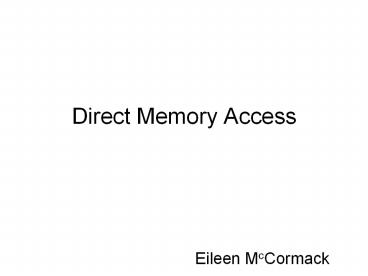Direct Memory Access - PowerPoint PPT Presentation
1 / 12
Title:
Direct Memory Access
Description:
Understand the benefits of DMA Use. Presentation Outline. Definition of DMA and Benefit of Use. Brief Review of CPU Driven Memory Access ... – PowerPoint PPT presentation
Number of Views:3659
Avg rating:3.0/5.0
Title: Direct Memory Access
1
Direct Memory Access
- Eileen McCormack
2
- Learning Objectives
- Able to Define Direct Memory Access (DMA)
- Generally describe the DMA transfer process and
the Key hardware involved - Understand the benefits of DMA Use
- Presentation Outline
- Definition of DMA and Benefit of Use
- Brief Review of CPU Driven Memory Access
- Overview of DMA Process
- DMA Controller
- Summary
- Bibliography
3
Direct Memory Access (DMA)
- Direct Memory Access (DMA) allows for the reading
of and writing to of Memory without transmitting
data/addresses through the CPU - DMA provides increased efficiencies by
- Allowing higher transmission rates to Memory than
those provided by CPU - Freeing the CPU for more productive use of cycles
4
Overview of Direct Memory Access
- Each I/O device can be DMA capable or the I/O
devices can be connected to a DMA controller - The DMA has an address. Two or more I/O devices
can share the same address. - The DMA controller contains
- Buffers (data, address)
- Registers(address, count, control)
- Control Logic
DMA Controller
I/O Device DMA Capable
I/o Device DMA Capable
I/O Device DMA Capable
I/O Device
I/O Device
5
CPU Driven Memory Access
- CPU issues R/W request, sends memory address,
sends data if write (semisynchronous
transmission) along the bus. - Simple hierarchy, Memory searched starting with
Cache, then Main Memory, etc. Blocks moved from
rightmost Mem to Cache, Word to CPU - System to update Main Memory with Cache updates
(write through, write back) - Complete signal issued Memory to CPU, data (word)
sent to MD if read request
CPU
Memory Hierarchy
Address Bus
MA
Registers
Register
Main Memory
Data Bus
MD
Cache
Mem
R/W
Request
Complete
6
Overview of DMA Process
- DMA signals a bus request to the CPU to Become
Bus Master
MemControl
CPU
Memory
Address
Data
I/O
I/O Control
Memory Mapped I/O
CPU is default Bus Master, but DMA takes
precedence DMA asserts request, wait for bus
grant, asysnchronous Prioritization Systems for
Bus Arbitration -Daisy Chain ( Devices
pre-prioritized ) -Centralized (Individual
devices make request to central
unit) -Distributed (Individual devices make
prioritization)
7
DMA Initialization
- The CPU initializes the DMA providing it with
information needed to effect transfer including
memory address, count, transfer type - When BG 0, CPU can R/W to DMA. When BG is 1 ,
DMA is Bus Master and CPU can no longer
communicate unless the DMA passes the baton
8
Overview of DMA Process
- Bus Grant sent by CPU , DMA Transfer Proceeds
- DMA controller effects control signals to
handshake with I/O device. - Alternative transfer techniques can take place
- cycle stealing or word by word transfer where
DMA steals a cycle from the CPU to R/W. Bus
masterhip must be relinquished and reqained if
you just steal a cycle. - burst transfer allows for a block sequence
with a number of words transferred in a
continuous burst with bus mastership retained
until completion - Transfer and Control relationship The I/O
effects transfer on data bus under the auspices
of the DMA controller. During Transfer DMA
increments address, decrements count, and tests
to see if count 0 i.e. transfer is complete.
If not then checks to see if peripheral is making
DMA request to send next word/more data. If so
continue loop of word by word transfer until
entire block (count) is transferred. When count
0 and no peripheral request loop terminates. - Release bus when transfer complete
- Uses interrupts to signal CPU
- CPU default bus master
9
DMA Controller
- Central controllers with I/O connected called
channel - Each channel needs its own address and count
registers
DMA Controller
I/O Device
I/O Device
10
DMA Channel
- Selector Channel - one device at a time yet has
many devices connected. Has only one set of
registers. - Multiplexer Channel - can control several block
transfers at once. Has registers for each I/O
device connected
11
Summary
- Direct Memory Access provides an efficient way to
transfer blocks of data to memory by
circumventing the CPU, prioritizing request
amongst I/O devices, and interweaving bus demand
for memory to minimize idle time. - DMA makes use of a controller with buffers,
registers, control logic to control and effect
the transfer of data between memory and I/O
devices - DMA trades but never shares mastership with the
CPU for the memory bus
12
Bibliography
- Texts
- Computer Systems Design and Architecture,
Heuring, and Jordan, Pearson Prentice Hall 2004 - An Introduction to Computer Science, Schneider
and Gersting, thomson.com, 2nd Edition 1999 - Computer System Architecture, Mano, Prentice
Hall, 3rd Edition, 1993 - Computer Architecture, Baron, Addison Wesley
1992 - Advanced PC Architecture, Buchanan Wilson,
Addison Wesley 2001 - Internet Sites
- Direct Memory Access (DMA) Modes and Bus
Mastering DMA and Ultra DMA (UDMA) Modes
http///www.pcguide.com/ref/hdd/if/ide/modesDMA-c.
html - Direct Memory Access, en.wikipedia.org/wiki/Dire
ct_memory_access - Open Courseware
- Stanford University, C.Kozyrakis,
http/eeclass.stanford.edu/ee282, lecture 9-I/O - Rice University,C.J.Ganier, http//cnx.rice.edu/co
ntent/m11867/latest/ - MIT,http/ocw.mit.edu/OcwWeb/Electrical-Engineerin
g-and Computer-Science/6-828Fall2003 - Princeton University, Kai Li, http/www.cs.princet
on.edu/courses/cos318/ and http/www.princeton.edu/
wolf/EE464/overheads/ch4-2.ppt































